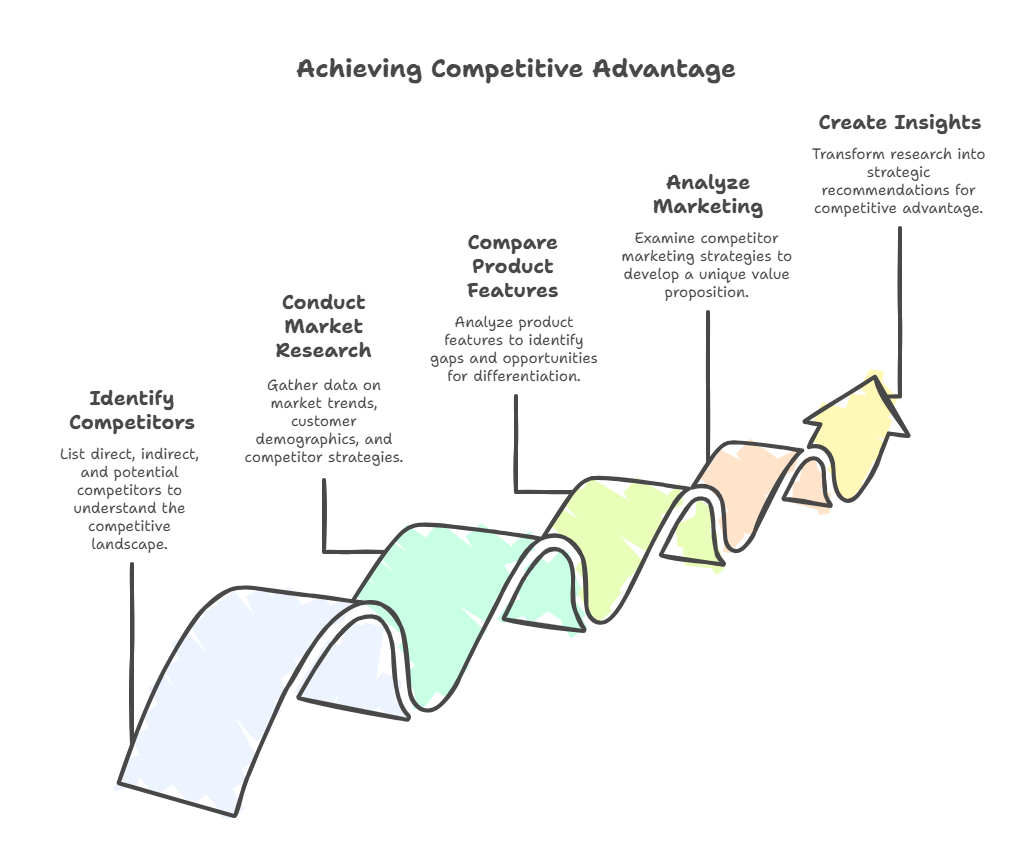How to Conduct Competitive Analysis: A Step-by-Step Guide
Learn how to conduct competitive analysis with our 5-step framework. Identify competitors, analyze their strategies, and gain market advantage for your business.
What is Competitive Analysis?
Competitive analysis is the systematic process of comparing your competitors against your brand to understand their core differentiators, strengths, and weaknesses. This strategic exercise helps businesses identify market opportunities, anticipate competitor moves, and refine their own positioning. When done correctly, competitive analysis provides actionable insights that can shape product development, marketing strategies, and business decisions.
Why Competitive Analysis Matters
Conducting regular competitive analysis offers several critical benefits for businesses of all sizes. It helps you reduce risks even while your business is still just a gleam in your eye by validating your business idea against existing market players. The process reveals patterns that are successful or unsuccessful to follow or avoid, saving you from costly mistakes. Most importantly, competitive analysis helps you learn from businesses competing for your potential customers and find your unique market advantage.
The 5-Step Competitive Analysis Framework

Step 1: Identify Your Competitors
Begin by creating a comprehensive list of both direct and indirect competitors. David Hunter, founder of Local Falcon, suggests that one of the best ways to identify competitors is by looking at who ranks for the same keywords your business is targeting. This approach reveals who's actually competing for your audience's attention online.
Consider these competitor categories:
- Direct competitors: Companies offering similar products/services to the same target market
- Indirect competitors: Businesses solving the same customer problem with different solutions
- Potential competitors: Companies that could easily enter your market space
Step 2: Conduct Market Research
Market research blends consumer behavior and economic trends to confirm and improve your business idea. This step involves gathering data about your competitors' market positioning, customer base, and overall business strategy.
Key research areas include:
- Market share and growth trends
- Customer demographics and psychographics
- Pricing strategies and business models
- Geographic reach and distribution channels
Step 3: Compare Product Features
Create a detailed comparison of your competitors' product offerings against your own. This comparison of product features helps identify gaps in the market and opportunities for differentiation. Focus on both quantitative features (specifications, capabilities) and qualitative aspects (user experience, design quality).
Consider using a feature matrix to visualize:
- Core functionality and unique features
- User interface and experience quality
- Integration capabilities and ecosystem
- Customer support and service levels
Step 4: Analyze Marketing and Positioning
Understanding how competitors position themselves in the market is crucial for developing your own unique value proposition. This involves examining their messaging, branding, content strategy, and customer acquisition channels.
Key elements to analyze:
- Brand positioning and messaging
- Content marketing strategy and quality
- Social media presence and engagement
- SEO strategy and keyword targeting
- Advertising channels and spend
Step 5: Create Actionable Insights
The final step transforms your research into strategic recommendations. Organize your findings into a clear framework that highlights competitive threats, opportunities, and recommended actions. This might include creating a spreadsheet with a row for each competitor and columns for important kinds of information you need to track.
Tools for Effective Competitive Analysis
While manual research provides valuable insights, leveraging the right tools can streamline your competitive analysis process. Consider using ClipMind's AI Competitor Analyzer to quickly gather and organize competitive intelligence. This tool helps you systematically compare multiple competitors across key business dimensions, saving time while ensuring comprehensive coverage.
Additional tools to consider:
- SEO analysis tools for keyword and backlink research
- Social media monitoring platforms
- Website analytics and traffic estimation tools
- Customer review and sentiment analysis platforms
Best Practices for Ongoing Competitive Analysis
Competitive analysis shouldn't be a one-time exercise. Establish regular review cycles to stay current with market changes and competitor movements. Schedule quarterly deep dives and monthly quick scans to maintain competitive awareness without overwhelming your team.
Remember that competitive analysis works best when it's integrated into your regular business planning processes. Use your findings to inform product roadmaps, marketing campaigns, and strategic decisions. The goal isn't to copy competitors, but to understand the competitive landscape so you can make better-informed decisions for your business.
By following this structured approach to competitive analysis, you'll gain valuable insights that help you anticipate market shifts, identify growth opportunities, and maintain your competitive edge in an ever-changing business environment.
 ClipMind
ClipMind